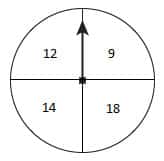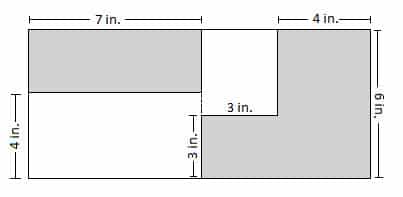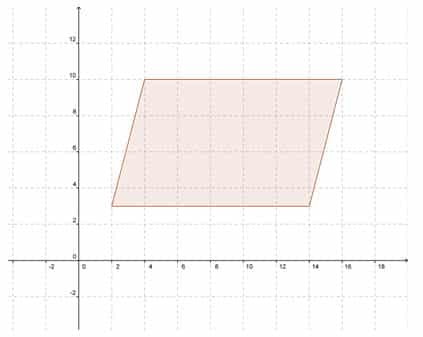PARCC Grade 7 Math Practice Test Questions
1. Edward spins the spinner below three times. If the spinner lands on a different number each time what is the highest total he could get?

1. A: I the spinner must land on a different number each time then the highest three numbers are 12,14, and 18. Added together they equal 44.
2. Which of the following is equivalent to 43+12÷4+82x3?
2. D: The order of operations states that numbers with exponents must be evaluated first. Thus, the expression can be rewritten as 64+12÷4+64x3. Next, multiplication and division must be computed as they appear from left to right in the expression. Thus, the expression can be further simplified as 64+3+192, which equals 259.
3. Given the figure below what is the area of the shaded regions? Figure is not to scale.

3. 45 square inches: The top left shaded region can be found by first finding the width. Since 6 in. is given as the width of the whole rectangle and 4 in. is given for the width of the non shaded region then the width of the shaded region is the difference of 2 inches. So, the area of that region is 7 in.x2in.=14 square inches. The other shaded region can be broken into a 3 in. by 3 in. square and a 4 in. by 6 in. rectangle. So, 3 in.x3 in.=9 ssquare inches and 4 in.x6 in.=24 square inches. Added together the total area is 45 square inches.
4. The number 123 is the 11th term in a sequence with a constant rate of change. Which of the following sequences has this number as its 11th term?
4. B: All given sequences have a constant difference of 12. Subtraction of 12 from the starting term, given for Choice B, gives a y-intercept of ?9. The equation 123=12x-9 can thus be written. Solving for x gives x=11; therefore, 123 is indeed the 11th term of this sequence. Manual computation of the 11th term by adding the constant difference of 12 also reveals 123 as the value of the 11th term of this sequence.
5. Ashton draws the parallelogram shown below. How many square units represent the area of the parallelogram?

5. 84: The area of a parallelogram can be found by using the formula A=bh, where b represents the length of the base and h represents the height of the parallelogram. The base and the height of the parallelogram are 12 units and 7 units, respectively. Therefore, the area can be written as A=12?7, which equals 84.